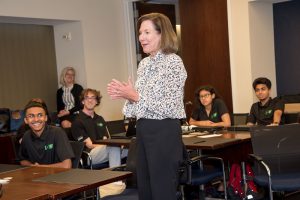Putting Students in High-need Communities on a Fast Track


NAF, originally known as the National Academy Foundation, has grown ambitiously. During the current school year, NAF is serving 109,000 students in 617 academies across the U.S. In 2017, NAF launched a new program called Future Ready Labs, an innovative internship concept designed to increase the quantity of meaningful, paid internships companies are able to support for our nation's future leaders. In an interview with From Day One, NAF's Chief Operating Officer Lisa Dughi explained how NAF works and why internships are important for high-school students. Excerpts:
Why does NAF focus its educational programs at the high-school level? Is that where the need is highest?

NAF was founded nearly 40 years ago to solve two issues simultaneously: to fill workforce pipelines with skilled and diverse talent, and to create an educational experience for disengaged youth that helped them make connections between what they were learning in school and the knowledge and skills they’d need to thrive in the workforce.
All these years later, this is still at our core. High school is the time when young people start making critical decisions about their career pathways. This is when they hone in on their interests, decide on their post-secondary path, and often what major they are going to choose. By targeting high school, we’re intervening at the right time to help students make the best possible choices for their futures.
How do NAF academies fit within existing public high schools?
NAF academy students participate in all the general, traditional course work and use their supplemental or elective time for their career courses and work-based learning activities. Students in NAF academies take both their general and career courses together to enable strong bonds to be created and to allow for integrated work across courses.
What goes into setting up a NAF academy, in terms of preparation and launching?
Those who are interested in establishing a NAF academy participate in an application process to outline their intent and the support available to ensure the success of the academy. Those that are accepted then enter into the Year of Planning program. NAF works to ensure all stakeholders are well-trained and confident in delivering on the NAF educational design and develops a lasting relationship with academies as they adjust the design to fit school or district needs.
What challenge are you addressing with the new Future Ready Labs?
There are not enough internship opportunities available for high school students, who benefit from practicing their hard-earned skills best in an internship environment. NAF Future Ready Labs enable employers to host more interns than they normally would, since the labs are established as structured group internships that are project-focused and completed in a shorter period of time than traditional internships.
Usually internships are associated with college students. Why are they so important at the high-school level?
Internships should be happening in high school and in college. By the time students are in college, they likely have already selected their major and their career path or may still be trying to figure it out. High-school internships give students the opportunity to gain practical experience and make better decisions about their future before getting to college and committing to something they may decide later isn’t for them. It also gives them a leg up when pursuing college internships.
How are the interns organized and put to work within companies?
Internship structures change from company to company. In general, in order for an internship to qualify for NAF’s employability credential, they must consist of 120 hours; payment of no less than federal or local youth training wage; direct supervision by an adult that is not the student’s teacher; produce work of value to the employer; and include a written individualized learning plan with targeted outcomes. The main emphasis is that students get the opportunity to be treated as an employee of that company and gain real-world experience.
What kinds of projects do the interns work on?

I think many employers are surprised by what high-school interns are able to contribute. NAF interns work on a variety of projects depending on their academy theme and the needs of their employer. For example, a finance student may create financial reports for the accounting department. Engineering students can assist mechanical engineers with computer-aided design (CAD) drawings. Health-sciences students can work in a doctor’s office or hospital and take patients’ vital signs. There are so many possibilities. This generation has an important perspective and unique capabilities.
In the first three labs you launched, in 2017, what did you observe?
We found that collaboration and commitment from planning partners were the key to success. With support, interns were able to grow as professionals, practice core career skills, assess their interests and abilities, and refine their career goals. Our first pilot was considered successful, and it shows. Following our first year, we expanded the number of Future Ready Labs from three to nine and for the summer of 2019, we anticipate even greater expansion.
What industries do you focus on in your programs?
NAF academies are focused on growth industries. They include engineering, finance, health sciences, hospitality & tourism, and information technology. NAF academies are meant to serve the needs of their local community’s workforce, so some academies adapt the NAF educational design to fit their specific needs. For example, we have academies in rural areas that focus on agriculture. We also have academies that focus on aviation and cybersecurity as there are vast opportunities for work in those fields.
You have a program called NAFTrack Certified Hiring. How does that work?
NAFTrack Certified Hiring is a groundbreaking initiative in which a growing number of top companies have committed to give special consideration to college students and eventual job applicants who, as high school graduates, earned NAFTrack Certification. It's achieved through an online system created by NAF for education and business leaders to assess college and career readiness. Student performance is measured through career-related coursework, a qualifying internship, and high school graduation.
How can companies and professionals get involved?
There are many different ways. NAF academies rely on business professionals to provide the work-based learning experiences that bring the educational design to life. When business professionals give just a little bit of their time to share their expertise with students, the impact is monumental. Anyone interested in getting involved can learn more here.
What do you, professionally and personally, find gratifying about NAF's mission?
I often say that it is hard to have a bad day when at the end of it, everything we do is focused on improving the lives of underserved and underrepresented students, their families, and their communities. Getting to hear the stories of our students and alums whose lives and futures are transformed by the experiences they have in their NAF academies, and having the opportunity to see the successes they are able to achieve as a result, makes every day working at NAF better than the last. Our nation’s future is sitting in classrooms across the country and having a positive impact on many of those students is certainly time very well spent.
Steve Koepp is a co-founder of From Day One. Previously, he was editorial director of Time Inc. Books, executive editor of Fortune and deputy managing editor of Time
The From Day One Newsletter is a monthly roundup of articles, features, and editorials on innovative ways for companies to forge stronger relationships with their employees, customers, and communities.